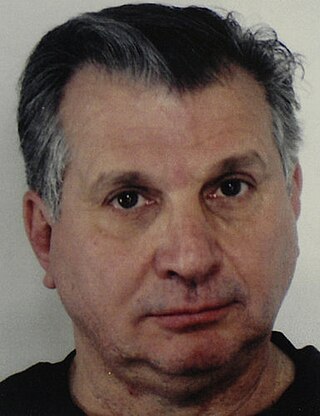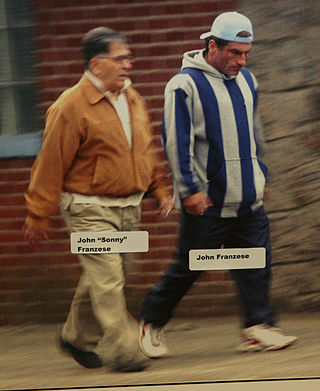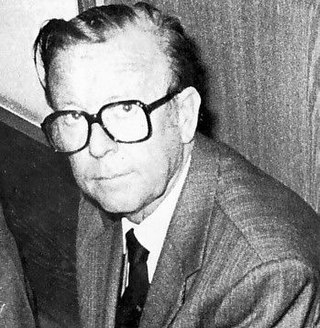Related Research Articles
A plea bargain is an agreement in criminal law proceedings, whereby the prosecutor provides a concession to the defendant in exchange for a plea of guilt or nolo contendere. This may mean that the defendant will plead guilty to a less serious charge, or to one of the several charges, in return for the dismissal of other charges; or it may mean that the defendant will plead guilty to the original criminal charge in return for a more lenient sentence.
In law, a witness is someone who, either voluntarily or under compulsion, provides testimonial evidence, either oral or written, of what they know or claim to know.
Murder, Inc. was an organized crime group active from 1929 to 1941 that acted as the enforcement arm of the National Crime Syndicate – a closely connected criminal organization that included the Italian-American Mafia, the Jewish Mob, and other criminal organizations in New York City and elsewhere. Murder, Inc. was composed of Jewish and Italian-American gangsters, and members were mainly recruited from poor and working-class Jewish and Italian neighborhoods in Manhattan and Brooklyn. It was initially headed by Louis "Lepke" Buchalter and later by Albert "Mad Hatter" Anastasia.
The Gambino crime family is an Italian-American Mafia crime family and one of the "Five Families" that dominate organized crime activities in New York City, within the nationwide criminal phenomenon known as the American Mafia. The group, which went through five bosses between 1910 and 1957, is named after Carlo Gambino, boss of the family at the time of the McClellan hearings in 1963, when the structure of organized crime first gained public attention. The group's operations extend from New York and the eastern seaboard to California. Its illicit activities include labor and construction racketeering, gambling, loansharking, extortion, money laundering, prostitution, fraud, hijacking, and fencing.

Joseph Charles Massino was an American mobster. He was a member of the Mafia and boss of the Bonanno crime family from 1991 until 2004, when he became the first boss of one of the Five Families in New York City to turn state's evidence.

Salvatore "Good Looking Sal" Vitale is an American former underboss of the Bonanno crime family before he became a government informant. After his arrest in 2003, Vitale agreed to cooperate with the government and testify against his brother-in-law, boss Joseph Massino, and in July 2004, Massino was convicted in a RICO case. Vitale had admitted to 11 murders, however, in October 2010, was sentenced to time served due to his cooperation, and entered the witness protection program.
The Bufalino crime family, also known as the Pittston crime family, Scranton Wilkes-Barre crime family, Northeastern Pennsylvania crime family, Northeastern Pennsylvania Mafia, or Scranton Mafia, was an Italian-American Mafia crime family active in Northeastern Pennsylvania, primarily in the cities of Scranton, Wilkes-Barre, and Pittston.

An informant is a person who provides privileged information, or information intended to be intimate, concealed, or secret, about a person or organization to an agency, often a government or law enforcement agency. The term is usually used within the law-enforcement world, where informants are officially known as confidential human sources (CHS), or criminal informants (CI). It can also refer pejoratively to someone who supplies information without the consent of the involved parties. The term is commonly used in politics, industry, entertainment, and academia.
Supergrass is a British slang term for an informant who turns King's evidence, often in return for protection and immunity from prosecution. In the British criminal world, police informants have been called "grasses" since the late 1930s, and the "super" prefix was coined by journalists in the early 1970s to describe those who witnessed against fellow criminals in a series of high-profile mass trials at the time.
Shareef Cousin is an African-American man from New Orleans who was convicted of the first-degree murder of Michael Gerardi in 1996 and sentenced to death as a juvenile in Louisiana. At age 17, he became the youngest condemned convict to be put on death row in Louisiana, and one of the youngest in the United States.
Witness immunity from prosecution occurs when a prosecutor grants immunity to a witness in exchange for testimony or production of other evidence.
Nicholas W. Calabrese was an American mob hitman, best known for being the second made man ever to testify against the Chicago Outfit. His testimony and cooperation with federal prosecutors helped result in the 2007 murder convictions of mobsters Joseph Lombardo, James Marcello, and his own brother, Frank Calabrese Sr.

Gaspare Spatuzza is a Sicilian mafioso from the Brancaccio quarter in Palermo. He was an assassin for the brothers Filippo and Giuseppe Graviano who headed the Mafia family of Brancaccio. After the arrest of the Gravianos in January 1994, he apparently succeeded them as the regent of the Mafia family. He was arrested in 1997 and started to cooperate with the judicial authorities in 2008. In his testimony, he stated that media tycoon and then prime minister Silvio Berlusconi made a deal with the Sicilian Mafia in 1993 that put the country in the hands of Cosa Nostra.

The assassination of Róbert Remiáš took place on April 29, 1996, in Karlova Ves, Bratislava, Slovakia. Remiáš, an ex-police officer, was one of the key figures in the trial against Slovak Information Service in the case of the kidnapping of the Slovak President's son into Austria from 1995. Remiáš's car was remotely detonated in the middle of a busy crossroad at Karloveská Street. There were numerous high-ranking mafia organised crime figures present at the crime scene watching the explosion, as well as Slovak Information Service operatives. The crime has never been solved. The anniversary of the assassination was often used by political parties critical of Vladimír Mečiar to call out for the annulment of his amnesties which prevented some key political crimes from the mid-1990s to be investigated.

John Franzese Jr., now living as Mat Pazzarelli, is an American former mobster and associate of the Colombo crime family, and son of former underboss John "Sonny" Franzese. He is the first son of a New York mobster to turn state's evidence and testify against his father.

Ernst Heinrichsohn was a German lawyer and member of the SS who participated in the deportation of French Jews to Auschwitz during World War II.
Napue v. Illinois, 360 U.S. 264 (1959), was a United States Supreme Court case in which the Court held that the knowing use of false testimony by a prosecutor in a criminal case violates the Due Process Clause of the Fourteenth Amendment to the United States Constitution, even if the testimony affects only the credibility of the witness and does not directly relate to the innocence or guilt of the defendant.
Kurt Rebmann was a German lawyer and from 1977 to 1990 'Generalbundesanwalt', the highest federal prosecutor of Germany.
The Kurdish trial in Düsseldorf was a major trial and span from between October 1989 to March 1994. It took place in a for this trial renovated court house at the High Court in Düsseldorf. The court room had to be adapted to the requirements for the case which demanded an extensive an amount of fifteen additional special compartments for the talks between lawyers and defendants. Additionally the trial demanded that court files like the declarations of witnesses, lawyers and judges were to be translated into the languages Turkish, Kurdish and German.
In Germany, a crown witness is a witness in a criminal trial who testifies against accomplices in order to receive a lower sentence from the prosecution. Crown witnesses came to prominence during the Red Army Faction (RAF) trials in the 1970s. The German Bar Association has criticized the system, claiming that testimony by crown witnesses often obstructs trials.
References
- ↑ Pomeroy, John Norton (1876). "State's Evidence". In Barnard, Frederick A. P. (ed.). Johnson's new universal cyclopædia a scientific and popular treasury of useful knowledge. New York; Pittsburgh, Pa.: A. J. Johnson & son. p. 495‒496.
- 1 2 3 Howard Abadinsky, Organized Crime (9th ed: Cengage Learning, 2010), p. 368.
- ↑ "Good practices for the protection of witnesses in criminal proceedings involving organized crime" (PDF). United Nations Office on Drugs and Crime. 2008. p. 19.
- ↑ W. McMordie, English Idioms and How to Use Them (Oxford University Press, 1954), p. 79.
- ↑ Sara M. Butler, Forensic Medicine and Death Investigation in Medieval England (Routledge, 2015), p. 151.
- ↑ King Jr., H. Lloyd (1999). "Why prosecutors are permitted to offer witness inducements: A matter of constitutional authority" (PDF). Stetson.edu: 160. Retrieved 1 November 2020.
- ↑ King (1999). pp. 160–161
- ↑ Rachel Monaghan (2019). "Loyalist supergrass trials: an opportunity for open source intelligence?". Intelligence and National Security. 34 (7): 1014–1026. doi:10.1080/02684527.2019.1646518. S2CID 201344178.
- ↑ "IRA members jailed for 4,000 years". BBC News. 1983.
- ↑ King (1999), p. 163
- ↑ Mark D. West, Secrets, Sex, and Spectacle: The Rules of Scandal in Japan and the United States (University of Chicago Press, 2006), p. 36.
- ↑ Chris Strohm, Mueller Uses Classic Prosecution Playbook Despite Trump Warnings, Bloomberg News (August 23, 2017).
- ↑ Evan Thomas, The Man to See (Touchstone, 1991), p. 407.
- ↑ Robert J. Kelly, Ko-lin Chin, Rufus Schatzberg, "Without Fear of Retribution: The Witness Security Program" in Handbook of Organized Crime in the United States (Greenwood, 1994), p. 499.
- ↑ "Ex-Mob Underboss Given Lenient Term For Help as Witness". nytimes.com. September 27, 1994. Archived from the original on January 5, 2019.
- ↑ Michael D. Lyman, Practical Drug Enforcement (3rd ed.: CRC Press, 2007), p. 85.
- ↑ Raab, p. 688.
- ↑ Janßen, Karl-Heinz; Brunner, Erwin; Riedl, Joachim; Sontheimer, Michael (21 November 1986). "Wunderwaffe Kronzeuge". www.zeit.de. p. 5. Retrieved 2020-11-01.
- 1 2 "KRONZEUGEN : Pakt mit dem König - DER SPIEGEL 13/1975". Der Spiegel. 23 March 1975. Retrieved 2020-11-01.
- ↑ ""Heute diene ich mit der reinen Wahrheit" - DER SPIEGEL 20/1979". Der Spiegel. 13 May 1979. Retrieved 2020-11-01.
- ↑ Janßen, Karl-Heinz; Brunner, Erwin; Riedl, Joachim; Sontheimer, Michael (21 November 1986). "Wunderwaffe Kronzeuge". www.zeit.de. p. 4. Retrieved 2020-11-01.
- ↑ "Gesetzentwurf der Fraktionen der CDU/CSU und F.D.P." (PDF).
- ↑ "Kronzeugenregelung wird verlängert". Die Tageszeitung: taz (in German). 1993-01-15. p. 2. ISSN 0931-9085 . Retrieved 2020-11-01.
- ↑ LTO. "Reform der Kronzeugenregelung: Wenn kriminelle Insider auspacken". Legal Tribune Online (in German). Retrieved 2020-11-01.
- ↑ "Bundeskartellamt - Bonusregelung - Bonusregelung". www.bundeskartellamt.de. Retrieved 2020-11-01.
- ↑ "§ 46b StGB: Die neue Kronzeugenregelung im Strafrecht". Juraexamen.info - Online-Zeitschrift für Jurastudium, Staatsexamen und Referendariat (in German). 2009-09-01. Retrieved 2020-11-01.
- ↑ Janßen, Karl-Heinz; Brunner, Erwin; Riedl, Joachim; Sontheimer, Michael (21 November 1986). "Wunderwaffe Kronzeuge". www.zeit.de. p. 6. Retrieved 2020-11-01.
- ↑ Robert D. Behn, Rethinking Democratic Accountability (Brookings Institution Press, 2001), pp. 47–48.